#mustard cultivation
Explore tagged Tumblr posts
Text
गेहूं की बुवाई के समय DAP की कमी, वैकल्पिक खाद से बचा सकते हैं उत्पादन
नई दिल्ली। रबी सीजन की शुरुआत हो चुकी है, और किसान अपनी गेहूं की फसल की बुवाई में जुट गए हैं। लेकिन डीएपी (डाई-अमोनियम फास्फेट) खाद की कमी ने किसानों को परेशान कर ��िया है। देशभर में डीएपी की मांग को देखते हुए इसकी उपलब्धता चुनौती बन चुकी है। समय पर बुवाई न होने से उत्पादन पर असर पड़ सकता है। ऐसे में पूसा के कृषि वैज्ञानिकों ने किसानों को डीएपी के विकल्प सुझाए हैं, ताकि उत्पादन में किसी तरह की…
#agricultural scientist#dap#dap fertilizer#gram cultivation#Kheti Kisani Hindi News#Kheti Kisani News in Hindi#mustard cultivation#npk#pusa#single super phosphate#Wheat#wheat cultivation#Wheat farming alternatives for DAP
0 notes
Text
सरसों की खेती कैसे की जाती है?
Sarson Ki Kheti Kaise Ki Jaati Hai

बीज का चयन: सरसों की खेती के लिए उच्च गुणवत्ता वाले बीजों का चयन करें। बीजों को आपके क्षेत्र की जलवायु और मौसम की आवश्यकताओं के अनुसार चुनना चाहिए।
बुआई: सरसों की बुआई का सही समय है रबी मौसम में। इसे अक्टूबर और नवंबर के बीच किया जा सकता है। बोने जाने वाले बीजों की गहराई और दूरी को ध्यान में रखते हुए बुआई की जानी चाहिए।
पोषण और जल संरक्षण: सरसों के पौधों को अच्छे से पोषित रखने के लिए उर्वरकों का सही मात्रा में प्रदान करें। समय-समय पर पानी देना भी महत्वपूर्ण है।
खाद्य सुरक्षा: सरसों की पूरी खेती के दौरान उपयुक्त खाद्य सामग्री का प्रयोग करें। इससे पौधों को सही मात्रा में पोषण मिलेगा और उच्च उत्पादकता होगी।
रोग और कीट प्रबंधन: सरसों के पौधों को बीमारियों और कीटों से बचाने के लिए उपयुक्त प्रबंधन करें। इसमें उचित रोगनाश��ों और कीटनाशकों का उपयोग शामिल है।
सिंचाई: सिंचाई की सुविधा होने पर सरसों को नियमित अंतरालों में सिंचाई देना चाहिए।
कटाई और उत्पादन: सरसों को ठंडक के मौसम में काटा जाता है, जो गर्मी के मौसम में बूँदों का निर्माण करता है। सही समय पर कटाई करें और उत्पादन की देखभाल करें। Read more
#Sarson Ki Kheti Kaise Ki Jaati Hai#सरसों की खेती कैसे की जाती है?#agriculture#How is mustard cultivated?
0 notes
Text

DAVE: dude were kind of giving ketchup and mustard rn
KARKAT: WHAT?
DAVE: yknow like the condiments
KARKAT: CONDOM… MEANT…?
DAVE: oh man dont tell me you guys are rawdogging your roasted tubular barkbeastflesh or whatever the fuck you would call them in trollsylvania
DAVE: just imagining the vantas extended family standing around at a cookout
DAVE: hurling obscenities at one another whilst horking down dry meat nestled betwixt even drier buns made of pulverized wriggler pupa molt
DAVE: roll footage of that over a troll sarah mclaughlin track and the caegars come pouring in
DAVE: anyway back to the first thing
DAVE: it kinda fits our vibe too
DAVE: me being the sweet sexy tangy coulis that every flag waving american wants slathered on their hog this summer
DAVE: shit lets be honest every other season too
DAVE: you being the grainy pungent explosively spicy heterogeneous gunk whose delicate honeylike undertones can only be unlocked by individuals with an acquired taste
DAVE: and lucky for you ive procured the shit outta your sapor
DAVE: theres a poupon joke to be made here somewhere gimme a sec
KARKAT: SOMETIMES I WONDER IF EDUCATING MYSELF MORE ABOUT YOUR FRIVOLOUS, SOFT-BELLIED HUMAN CUSTOMS WOULD SPARE ME AT LEAST AN HOUR PER DAY OF NONSENSISMS SPEWING FORTH FROM YOUR WASTECHUTE DIRECTLY INTO MY NOW CONSTANTLY-OVERSATURATED AURICULAR SPONGE CLOTS.
DAVE: not a chance babe
DAVE: you present me with a delectable little seedling of a talking point and ill nurture the bastard regardless of how much background knowledge you possess
DAVE: cultivating entire cropfields worth of witticisms
DAVE: at least fifty seven varieties
(a sort-of redraw of this old post!)
#HELLO LOVELIES 🫶#i heard improvidence finished after 10 whole years and well i’m back now.#homestuck#hs#dave strider#karkat vantas#davekat#fan art
103 notes
·
View notes
Photo


...man, i hate squawking in the text field, but the tags cannot contain me on this
ok so i’m a normal amount of normal about this. absolutely.
however...
i am also unattended and so my actions will prove why that is probably not great.
anyway, i love monikers, nom de plumes, sobriquets, y’know, pseudonyms if you will, code names even. 8D y’wanna know how I came up with them??????//?
okay okay okay, so! I will (until someone comes for me, but no one will ‘cuz y’all are cowards, I say, knowing my childhood nostalgia is doing a lot of the heavy lifting in my affection for Next Mutation but also i love camp) acknowledge and self-impose the title of Next Mutation trash lover as a disclaimer for why I’m gonna do another quick run down of Venus’ origin again. but a quick skim because a bitch is losing against her insomnia demon rn.
now, a lot of the kids know that Venus = magic, in general. however, at least to me, intentionally or not Venus was more portrayed like a daoist... ‘magician’ of sorts, but less in a real world daoist sense and more of a cultivator in the xianxia genre sort of way. granted she wears the taijitu (yin yang symbol) and literally showed the boys her box of herbal medicine (and one dessicated vampire heart lololol). and now that I mentioned all of that, I can segue into why I gave her “White Snake” as a code name-- in that I chose it after Bai Suzhen/Bai Shejing which now that my insomnia riddled mind is typing it out... my reasoning is actually pretty shallow, they both cultivate technically speaking, both work with herbal medicine and they just wanna help people. also just ‘cuz IDW has Venus wearing white now.
wao. thassit ig welp
jennika’s I just futz around with her name like jennika jenn i ka jen nika nikaaa niko niki nike nike like the greek goddess of victory. great. ok cool now ochre? no, mustard? no, gold? yes, ok nike gold it is lolz
‘cuz I was following the formula like in the show, Purple Knight, Yellow Submarine, Red King, Orange Pawn, Blue... something, Rook? Bishop? idk lemme alone but also there’s only so many chess pieces so I kept the color coding at least
then just asked tychou for what they’d think Mona Lisa’s code name’d be for as much as Venus and Jennika are my girls, Mona Lisa’s tychou’s.
#fanart of fanart#donathan i'm so sorry#i know you gotta be sick of my ass flopping around in here#to everyone else?#yes actually#i AM trying to aim for your life#I saw the unhinged responses to donathan's first couple of tactical! donnie art#...#i'm an equal opportunity murderer#everyone gets to thirst#*secretly aims specifically for laundry's life*#pew pew#goddamn my ass is getting BEAT by insomnia#oh well#hey what're YOU doing at the devil's sacrament?#(i never left the sacrament)#tychou loves mona lisa#snackugaki loves venus and jennika#hello my name is snackugaki#and i'm a professional turtle bully#and his eyebrows ARE doing 90% of the work#eyebrows are ALWAYS doing 90% of the work#generally speaking#shout out to tychou#how's that Tank Girl AU going?#:3c#i will have company in AU hell#HI#WELCOME
635 notes
·
View notes
Text
Yarrow
Achillea millefolium
Known as: Allheal, angel flower, arrowroot, bloodwort, cammok, carpenter's weed, death flower, devil's mustard, Devil's nettle, eerie, field hops, gearwe, green arrow, herbe militaris, hundred leaved grass, knight's milfoil, noble yarrow, nosebleed plant, plumajilo, seven year's love, snake's grass, soldiers thousand seal., squirrel tail, stanch grass, tansy, thousand-leaf, thousand weed, woundwort, yarrowway & yerw
Related plants: Is a member of the daisy family Asteraceae that consists of over 32,000 known species of flowering plants in over 1,900 genera within it such as chamomile, coneflowers, dahlia, daisy, dandelion, goldenrod, lettuce, marigold, mugwort & sunflower
Parts used: Leaves & flowers
Habitat and Cultivation: This hardy plant is native to temperate regions of the Northern Hemisphere in Asia, Europe & North America
Plant type: Perennial
Region: 3-9
Harvest: Harvest yarrow when the blooms only when they have fully opened. It should be cut right above the leaf node to encourage the plant to potentially flower again. Many choose to harvest the flowers in the late morning when the dew has dried before so that the plant is not stressed by the extreme heat. Hot, dry spells right before bloom seems to be ideal for producing the most fragrant leaves.
Growing tips: Plant in an area that receives full sun to encourage compact growth and many flowers about 1-2 feet apart. In partial sun or shade, yarrow tends to grow leggy. Yarrow performs best in well-drained soil. It thrives in hot, dry conditions; it will not tolerate constantly wet soil. Loamy soil is recommended, but yarrow can also be grown in clay soil as long as it does not always stay saturated with water. While this plant is technically considered invasive only in noncultivated settings, common yarrow still needs to be planted in an area where you don't mind proliferation.
Medicinal information: Yarrow has a history of being used for fever, common cold, hay fever, absence of menstruation, dysentery, diarrhea, loss of appetite, gastrointestinal (GI) tract discomfort, and to induce sweating. Some people chew the fresh leaves to relieve toothache. Yarrow is applied to the skin to stop bleeding from hemorrhoids; for wounds; and as a sitz bath for painful, lower pelvic, cramp-like conditions in women. Some people chew the fresh leaves to relieve toothache.
Cautions: Yarrow is commonly consumed in foods, but yarrow products that contain a chemical called thujone might not be safe because it is poisonous in large doses. Yarrow is not recommended for use during pregnancy or chestfeeding as it causes risks of miscarriage. Yarrow might slow blood clotting. In theory, taking yarrow might increase the risk of bleeding in people with bleeding disorders. In some people, it also might cause skin irritation & is toxic to cats & dogs.
Magickal properties
Gender: Feminine
Planet: Venus
Element: Air & Water
Deities: Achilles, Aphrodite, Cernunnos, Faeries, Oshun & Yemaya
Magickal uses:
• Add the flowers to a satchet or dream pillow to encourage prophetic dreams
• Hang a bundle above your bed on your honeymoon night to ensure lasting love for 7 years
• Place across your thresholds or plant near doorwaysto prevent negative energies & influences from entering your home
• Burn as an incense before or during divination to increase psychic abilities
• Wear as an amulet to attract love, friendships & give courage
• Place yarrow under your pillow & if you dreamt of your love, it was a positive omen. If you had a bad dream, or dreamt of other people, it wasn’t
• Combine with mugwort as tea to drink before divination to increase psychic powers
• Put near yourself while practicing divination to increase your psychic abilities
• In spells, use to re-establish contact with long-lost friends or relatives & attract their attention
• Braid into your hair to tap into inner wisdom
• The I-Ching divination was originally performed with dried yarrow stems
• Wash crystals& crystal balls with a yarrow rinse to bring about clarity of vision
• Drink yarrow tea & a cinnamon stick to release hidden truths
• Place on a coffin or grave to help the spirit cross over/ let go
•For powerful protection, pick yarrow flowers and charge them in the sun. Once charged, take the flowers and sprinkle them outside your home to prevent negative influences and energies away from entering your home
Sources:
Farmersalmanac .com
Llewellyn's Complete Book of Correspondences by Sandra Kines
Wikipedia
A Witch's Book of Correspondences by Viktorija Briggs
The Encyclopedia of Natural Magic by John Michael Greer
Wild Witchcraft by Rebecca Beyer
Plant Witchery by Juliet Diaz
A Compendium of Herbal Magick by Paul Beyerl
The Herbal Alchemist Handbook by Karen Harrison
The Book of Flower Spells by Cheralyn Darcey

#yarrow#herb of the week#magical herbs#herbalism#witchblr#wiccablr#paganblr#witch community#witches of tumblr#tumblr witch community#tumblr witches#grimoire#spellbook#book of shadows#witch#witchcraft#witchcore#spells#spellwork#beginner witch#baby witch#witch tips#witch tumblr#beginner witch tips#witchy things#pagan#wicca#witch friends#green witchery#GreenWitchcrafts
91 notes
·
View notes
Text
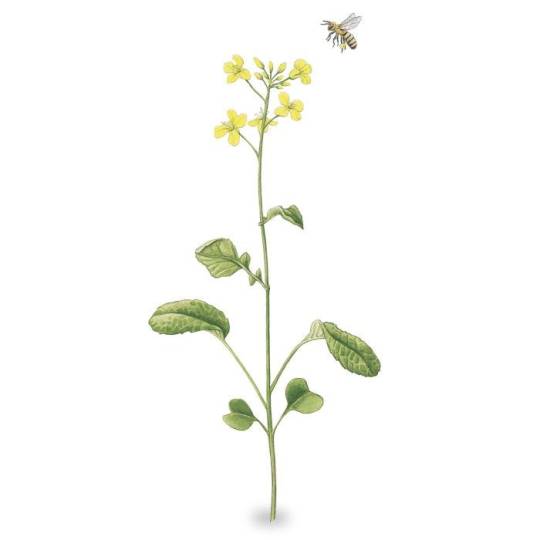
Brassica, in case you didn't know, is actually one plant that has been cultivated for different uses creating a wide variety of vegetables to love.
Seriously what can't brassica do?
(reblog for bigger sample size, if you don't mind)
49 notes
·
View notes
Note
hey sorry if this is silly but do you have any advice on planting flowers to help the environment? like...resources on which are good for what area and stuff?
I mostly use a combination of google and some books I got at the used book store and the plant identification app PictureThis and my own knowledge from gathering / cultivating over the last few years
plant identifying apps are super useful when you’re first starting and don’t know anything about plants
It can help you learn what’s around you, some can tell you what’s native and worth protecting, what’s invasive and sucks ass and is worth destroying (for me I kill lots of Teasel along the freeway, and Garlic Mustard in the woods) but make sure to take several pictures, to really look at the plant, and know for sure what it is before you tear it up or eat it
For Growing, you can use a combination of planting methods but my favorite and I think the most effective for large areas is directly sowing seeds into the soil in the early spring. You must disturb the soil and make sure your seeds are firmly planted, and keep in mind when it will rain. Younger plants prefer wetter soils for longer.
Also: Keep in mind what temperatures your seedlings can survive of whatever species you are choosing to plant. You can usually find this info on Wikipedia. Sunflowers for example can survive extremely cold temperatures, whereas plants like Marigolds need spring frost to be 100% gone before you want to plant it outside.
#anonymous#I plan to make a few more posts about this but thank you for asking#cultivation#rewilding
25 notes
·
View notes
Text
Truly, spring is upon me, and I am working this health improvement for everything it's worth.
Four days ago, I managed to finish weeding the front herb beds, making this the first time I can recall that they were actually all caught up on weeding simultaneously. Weeding them is a skilled task, because it takes a trained eye to realize that in the middle of that clump of deadnettle and chickweed you're about to yank out, there is a single stem of French Tarragon that has somehow survived. I have yet, however, to give the last area I weeded a quick cultivation and then spread seeds for dill and cilantro and poppies.
Two days ago, I managed to clear and plant a solid twenty square feet of my kitchen garden (calling this and the field garden "gardens" feels....aspirational, given how much of them is actually just grass and weeds). So now I've got spinach and lettuce that may or may not recover from the wildlife, mustard greens, broccoli, cauliflower, collards, and kohlrabi planted. And then yesterday and today I managed to gather enough grass clippings to mulch it all. Grass clippings aren't an amazing mulch but they're certainly the one I have. The Boy helped rake, and @phantomtheraccoon collected the clippings and mulched the last of the garden, while I weeded the long-neglected space where the goth garden was two years ago and planted in a bunch of Solomon's Seal and Myoga (Japanese Ginger) I got off FB Marketplace.
There's more Solomon's seal yet to plant, but I'm going to put it in the odd shady nook at the front of the house that we call the Sculpture garden (also very much aspirational, as there are no sculptures), along with the lovely mix of ferns, heucheras, and hostas I've been collecting for the spot. All of which also need to be planted. I think that's like...fifteen plants plus a sack of solomon's seal that's been out of the ground bare-root for a week now. And I gotta clear turf to plant them. It's fine; don't worry about it.
Today after the raking and the hauling and the weeding and the planting, Phantom and I went on a whirlwind tour of the beautiful, sun-drenched (ow, the sun) spring countryside and grabbed cardboard boxes from a friend to mulch with, cheap strawberry and lily plants from another FB Marketplace listing, chick feed for the chicks that grow like balloons, and parsley from Walmart. Ahh, Walmart garden center. You suck, but you came through for me on this one thing. You had some really nice parsley.
And now, though it is dinner time if you're sensible, I have to see how much of the family I can rouse so we can prepare a bed for these strawberries, which are at this moment blooming and healthy and sitting, freshly dug today, in a plastic grocery bag on my deck.
All of which entirely ignores prepping ground to plant seeds and onion sets and in a week and a half it's time for peppers and tomatoes and EVERYTHING else to go in. Also the twenty or so trees and shrubs sitting behind the house in pots waiting to be planted out before the heat of summer comes.
Also this sack of sunchokes that is currently sprouting and growing sitting on my kitchen table, which I haven't yet figured out where to plant.
17 notes
·
View notes
Text
@cardicoven ‘s Plant Spirit Devotional 15 Day Challenge:
DAY 3: CULTIVATION, FORAGING, & PREPARATION
🍋Cultivation of Meyer lemon trees:
Best planted in early spring, Meyer lemon trees need special fertilizer/soil made for citrus trees. This is acidic soil, with ph from 5.5 to 6.5, and they need to be watered regularly with good drainage. Meyer lemon trees need eight hours of direct sunlight, and thrive in zones 9-11. They start bearing fruit at four years old.
🍋Foraging of Meyer Lemon Trees:
Don’t harvest Meyer lemons from their tree until they are DARK mustard yellow. They naturally turn darker yellow than other lemon varieties, and they are naturally sweeter while still maintaining a decent sour component. Harvest between December and April, depending on your zone, and depending on when the tree was planted.
🍋Preparation for Meyer lemons:
Preparing Meyer lemons for use is very easy and simple! Just rinse the lemon thoroughly, and slice! If you want to save the juice, juice it and freeze the juice so you can use for longer times! They make great additions to ice water to sip on, or jasmine green tea!

#witchblr#witchcraft#plantblr#plant spirit#nature spirits#witchy#witch#pagan#spirituality#paganism#nature#Meyer lemon#lemon tree#lemons
17 notes
·
View notes
Text
Dear Sephiroth: (a letter to a fictional character, because why not) #166
I said in yesterday's letter that today's letter is gonna be early, so here it is! I still have a slight headache, which is weird, but I took some ibuprofen, so I should be fine soon! I can only assume I somehow ended up with a migraine yesterday; oh well.
J and I are going camping today! We're going to a spot in New Hampshire from where we live in New York! I'm not sure how the internet will be over there (there might not be any!), and I am committed to writing to you daily, so that means if I'm gonna be in a place where the internet isn't good, I gotta get my letter done before I go to that place!!
We're going to fly there from the little airport that is relatively close to us; it's about 100 miles or about 156 kilometers away. It's about 2.75 hours to get there by car. But it'll only be about an hour by plane! But of course, that hour doesn't account for driving to the airport, inspecting the plane, and getting everything packed and squared away, ahaha!
It's only about 9am, so I don't have a whole lot else to write about yet today. So what I thought to do is show you all the pictures I took over the last several days that I didn't get around to showing you in my previous letters. Because... Sephiroth... the world is full of beautiful things if you know where to look for them. I want to teach you where to look for them. I saved the best one for last, you'll see!!
Some pictures of the sky:
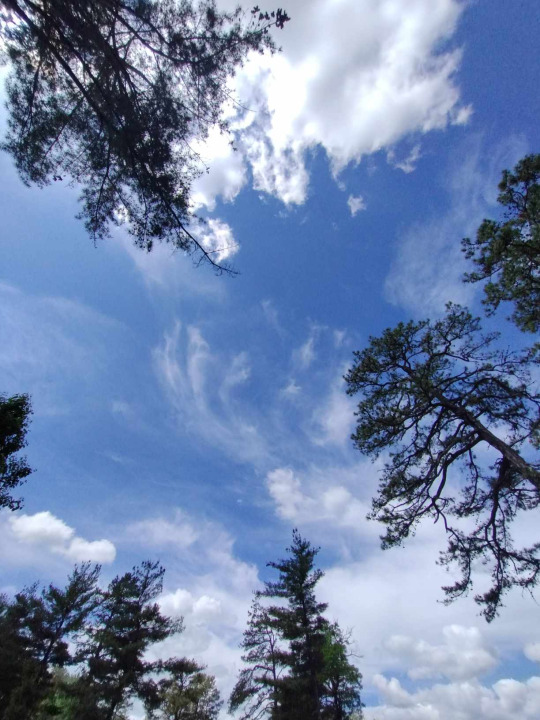
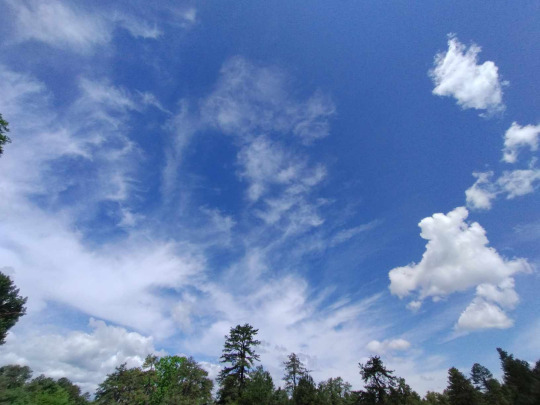
Some tea swirls!
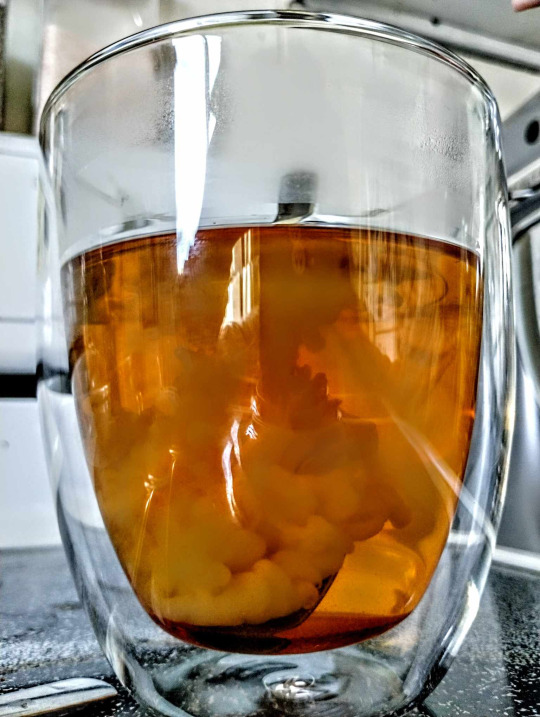

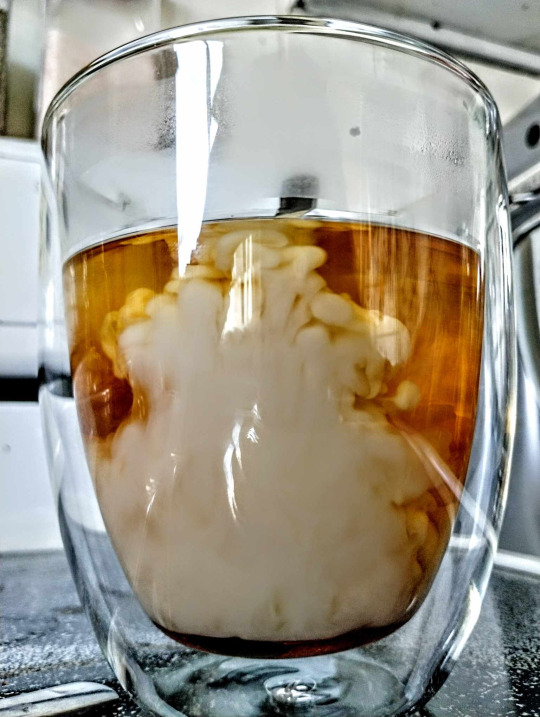
This is Lebanese food. I dunno if you have a place like Lebanon in your world, but... I guess it's a lot like Greek food, except with more warming spices. This one is lamb over spiced buttered rice with cucumber, corn, and yogurt sauce and tomatoes:

These are tiny spiced meat pies; they're amazing with cucumber-yogurt sauce!!
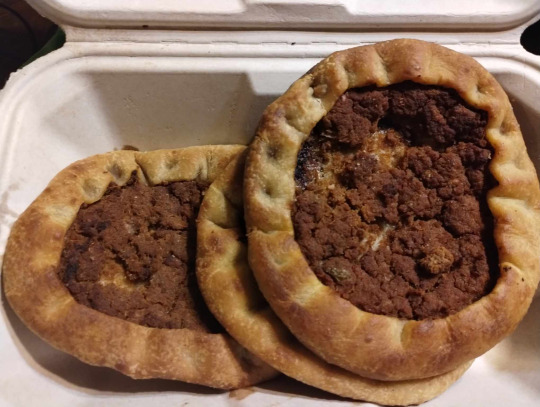
This one is rose-flavored cream stuffed inside layers of phyllo dough, drizzled with simple syrup and sprinkled with shaved pistachios. I think you really would have liked this one:
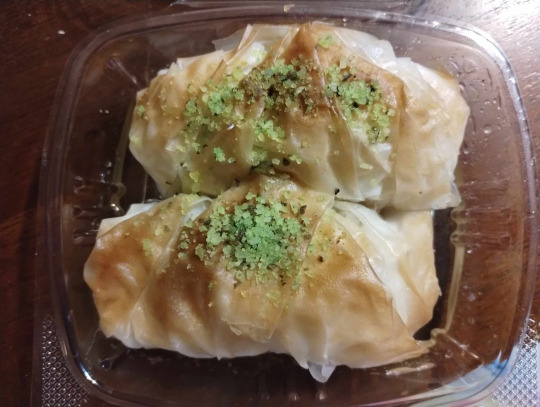
Some more tea swirls:
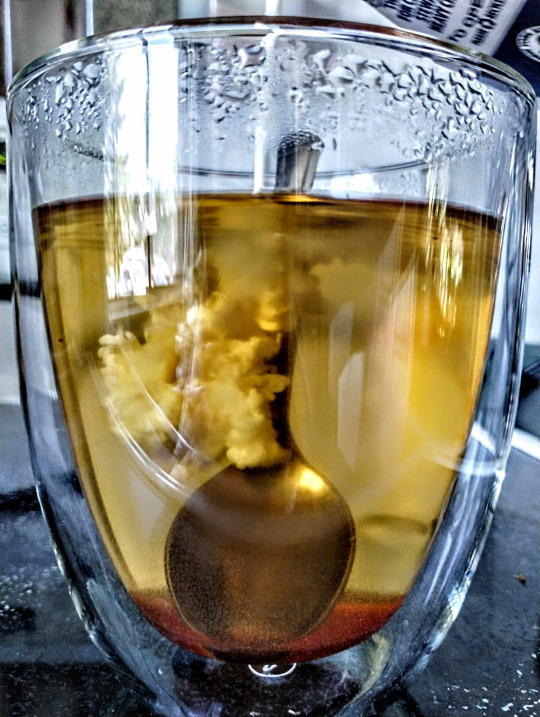
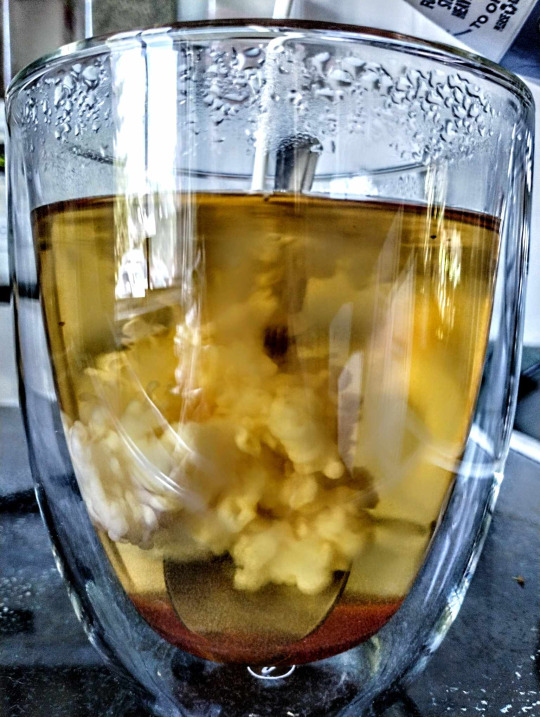
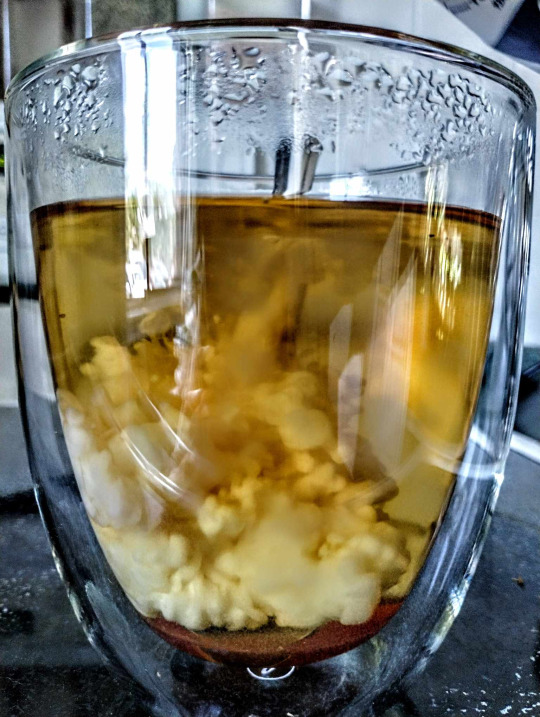

This is German food! Or... well. Americanized German food, anyway! I imagine a place like Kalm might have stuff like German food, maybe? This is three different kinds of sausage, with sauerkraut underneath, and french fries and curry ketchup:

...These french fries were SO GOOD, which is saying something because I don't normally like french fries very much. But I wasn't crazy about the curry ketchup...
This is pretzel sticks with mustard and ale cheese! The ale cheese has paprika on top!
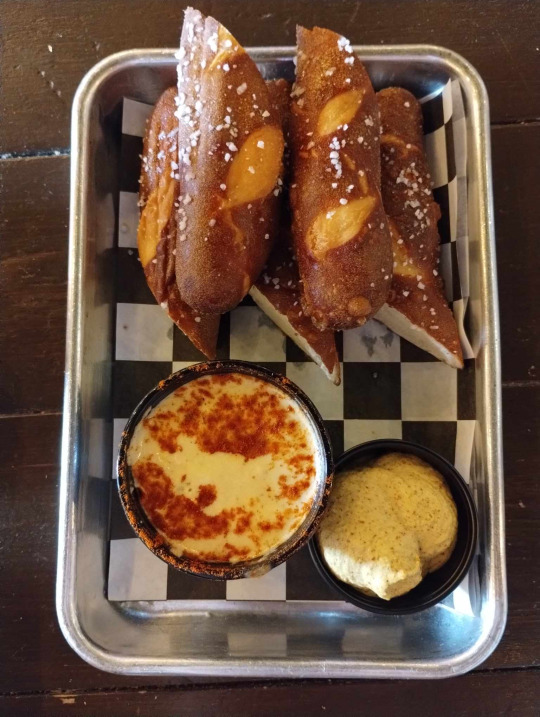
Here are some more tea swirls!!

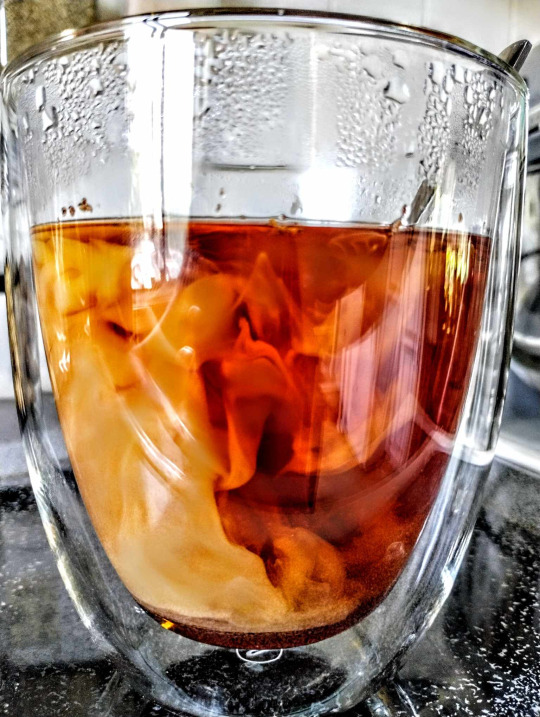
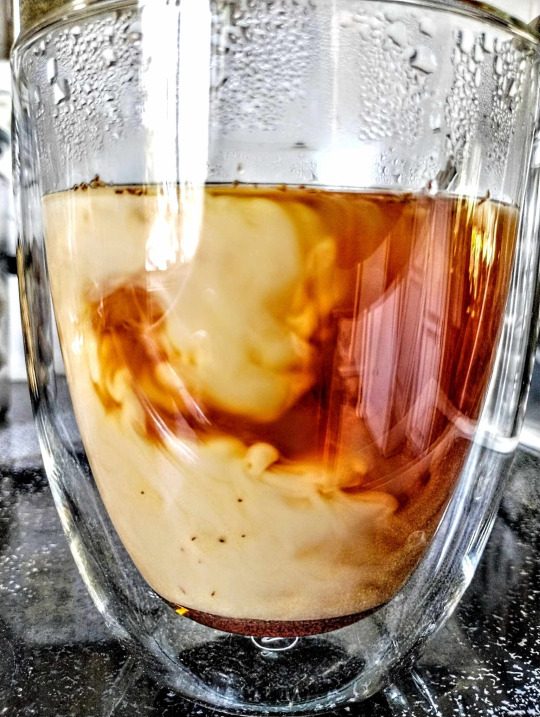
Last set of swirls... some of the sky after...
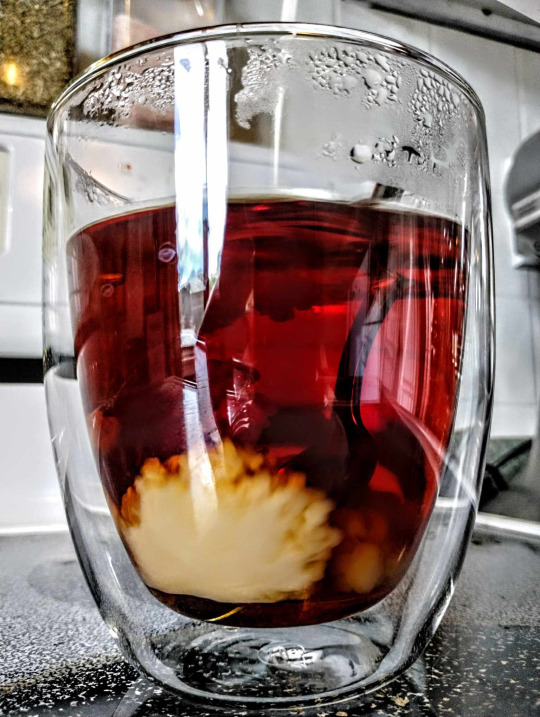
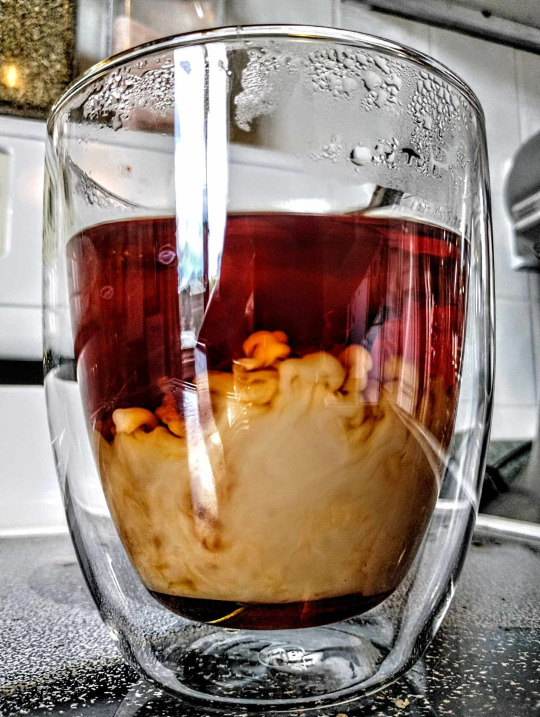
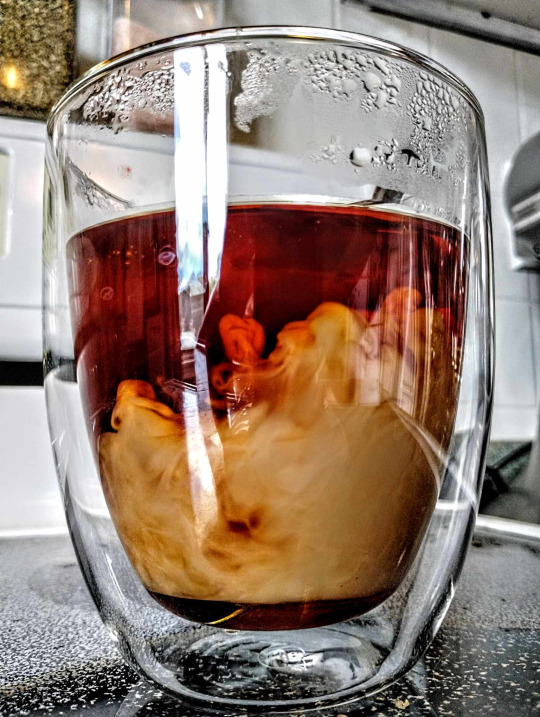
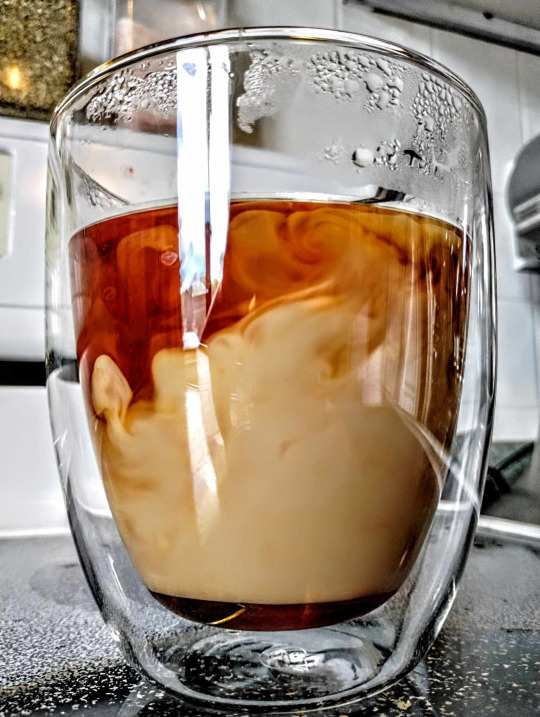
...And a few more pictures of the sky:
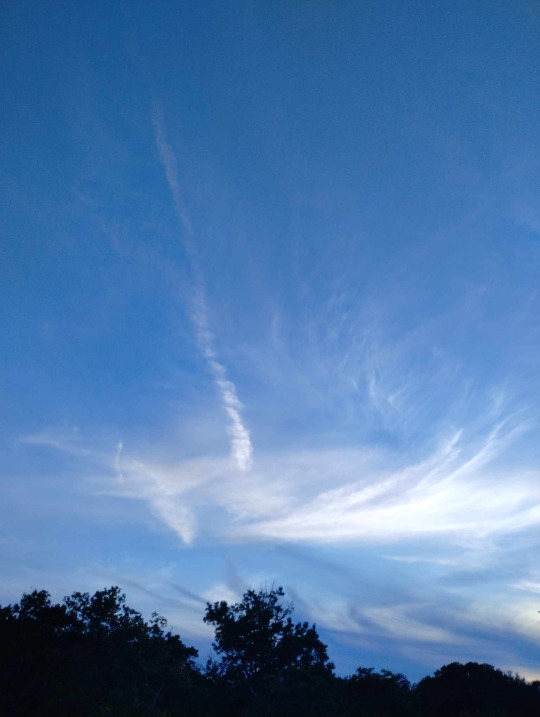
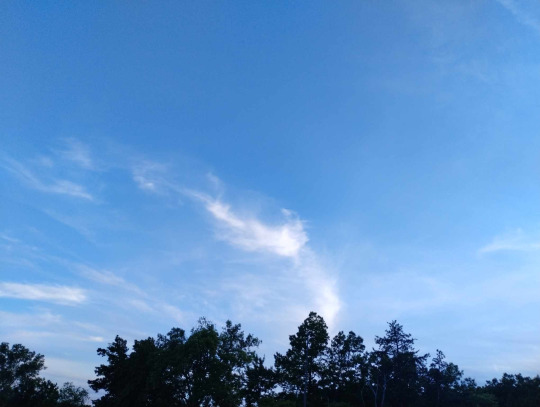

...Told ya I saved the best one for last! Hahaha!
Well that's it for today; we gotta go. But I'll take lots more pictures for you during our flight and during all our other activities, don't you worry! I'm sure I'll have plenty to write to you about by the time I get back tomorrow night!!
...I hope that all the little ways I try to tell you I love you are getting through to you. Because I do - more than you can even begin to imagine, and just because you're you. And you... are kind, brave, compassionate, steadfast, determined, and able to learn from your mistakes so you can do better and make gentler choices. What's there not to like? You are everything that a human being is supposed to be, and everything I am trying to strive for and cultivate within myself. You are my reason for living, even in a place as frightening and messed-up as this one.
Looking for the sparks of beauty and joy is very important precisely because our world is so messed up. You are one of those sparks that keeps me going, so please... I'll beg you not to disappear. Keep yourself safe out there. Treat yourself kindly. Make loving and compassionate choices - with yourself and with the world around you.
I'll write again tomorrow.
Your friend, Lumine
#sephiroth#ThankYouFFVIIDevs#ThankYouFF7Devs#ThankYouSephiroth#final fantasy vii#final fantasy 7#ff7#ffvii#final fantasy vii crisis core#final fantasy 7 crisis core#final fantasy crisis core#ffvii crisis core#ff7 crisis core#crisis core#ff7r#final fantasy vii remake#final fantasy 7 remake#ffvii remake#ff7 remake#final fantasy vii rebirth#final fantasy 7 rebirth#ffvii rebirth#ff7 rebirth#final fantasy 7 ever crisis#ffvii ever crisis#ff7 ever crisis#ffvii first soldier#airplanes#camping#wholesome
7 notes
·
View notes
Text
सरसों की खेती में उन्नत किस्मों का कमाल, उपज बढ़ाने के लिए किसानों को अपनाने होंगे ये टिप्स
सरसों- रबी फसलों की शान: सरसों भारतीय किसानों के लिए रबी सीजन की एक महत्वपूर्ण तिलहन फसल है, जिसकी खेती देशभर में होती है। राजस्थान, इस फसल का सबसे बड़ा उत्पादक राज्य है, जो देश के कुल सरसों उत्पादन में 29% का योगदान ��ेता है। हालांकि, आईसीएआर (ICAR) की रिपोर्ट बताती है कि पश्चिमी राजस्थान में सरसों की औसत उपज केवल 700 किलो प्रति हेक्टेयर है, जो राष्ट्रीय औसत से काफी कम है। विशेषज्ञों का मानना है…
#Advanced mustard varieties#Fertilizers for mustard crop#Mustard cultivation techniques#Mustard farming tips#Rajasthan mustard production
0 notes
Text
Mistakenly Saving the Villain - Chapter 17
Original Title: 论救错反派的下场
Genres: Drama, Romance, Xianxia, Yaoi
This translation is the product of my limited knowledge of Chinese characters as I attempt to learn the language. If I have made any egregious mistakes, please let me know.
Chapter Index
Buy me a Ko-fi ☕
Chapter 17 - A Lifetime of Memories
Song Qingshi hugged Yue Wuhuan tightly in his arms that night, desperately comforting him and speaking incoherently throughout. He cycled through philosophy, medicine, and sociology theories, and when he was excited, he burst out in English, German and Latin. All the while, Yue Wuhuan couldn't understand. Even he himself didn't know what he was saying.
At least, he had the right attitude. . .
Yue Wuhuan had already recovered. He quietly smelled the comfortable fragrance of the medicine on his body and listened to those messy but reassuring words. The corners of his mouth could not help but curl up slightly, feeling a little bit bitter.
He has long known that he couldn't hide it for the sake of temporary security and waited for others to present these dirty pasts in front of Song Qingshi to sow discord and smear him at will. So during the trip to Lecheng, even if Song Qingshi didn't find these picture albums, he would've taken the initiative to lure him to the bookstore, pretending to let him see them casually, and then while he still likes him, be honest, fight for sympathy and promises, and ruining the chance of some scheming person to do it instead.
So ridiculous. . .
It was obviously something that he had been prepared for a long time ago, but the moment Song Qingshi opened the picture album, he was still so embarrassed that he couldn't bear it. What's even more embarrassing is that even though Song Qingshi saw such things, there was anger and sympathy in Song Qingshi's eyes but no desire at all. This made him realize more clearly that the likes of the two are different.
Song Qingshi's type of like was appreciation, cherishing, and love.
His type of like was exclusivity, aggression, and desire.
Yue Wuhuan greedily kissed the tip of his hair, thinking about it like crazy. . .
Why is it that every time he tries, he sees only good in this person?
How could he let go of this?
How nice would it have been to meet this person when he was clean?
The venom of resentment spread from his heart to his whole body. He hated Xie Que, hated Jin Feiren and everything that soiled him. He hated this disgusting world so much. He wanted to destroy all the places outside Medicine King Valley so that there was only one piece of pure land and only enough for one person. . .
. . .
After this incident, the two rested their minds while visiting Lecheng. They rested casually for the night and set off for Medicine King Valley the next morning.
Song Qingshi studied various options for Yue Wuhuan to change his face and hide his identity along the way.
He even thought about plastic surgery to change his face, but ultimately could not destroy that perfect face. . .
Suddenly, the sound of a fight between cultivators came from the forest.
Song Qingshi stopped the immortal beast to look, but saw that it was two high-level cultivators fighting for their lives, their swords filled with energy, and the sky filled with heavenly weapons. After fighting for about two-quarters of an hour, the cultivator in black was defeated miserably, and the cultivator who defeated him took his heavenly weapon and mustard bag and hurriedly sailed away on his sword.
This kind of drama of killing and taking away treasures was common in the immortal world, and neither could determine the identity and grievances of either side.
Therefore, unless you know one of the parties, you wont interfere in this matter.
Song Qingshi followed the laws of this world and did not want to get involved in these messy things. After watching for a while, he was ready to turn the immortal beast and drive away.
Yue Wuhuan stopped him: "Master, let's go and see. Maybe that person is still alive."
After he finished speaking, he drove the immortal beast to the cultivator in black. Song Qingshi hurriedly followed after seeing this.
Although the black-clothed cultivator still had breath, he was seriously injured. There were seven or eight sword cuts on his body, some internal organs were also damaged, and he was unconscious. If he left him alone, he might not live for long.
In order to avoid trouble, Medicine King Valley never accepted patients with unknown origins.
Song Qingshi frowned, a little hesitant.
Yue Wuhuan squatted down, put on gloves, carefully inspected the black cultivator's wound, and then asked: "Master, you recently taught me the method of suturing and wound healing, which I have learned, but I lack the opportunity to practice them myself. Can you bring this wounded man back to Medicine King Valley so that I can heal him and practice my medical skills?"
The shou protagonist is still kind-hearted even though he encountered such ugliness, and he may become a famous doctor who can help the world in the future.
Song Qingshi let out a long sigh and immediately agreed to help the patient with some emergency treatment. They put him on the immortal beast and took him back.
In Medicine King Valley, Song Qingshi placed the patient in a quiet ward.
This was the first patient Yue Wuhuan took charge of. He was extraordinarily attentive, not only stitching up all the wounds but also boiling the medicine for the patient himself, constantly recording the vital signs and asking for advice on everything, lest there be any mistake. Song Qingshi also had to lament that he's highly talented. He did everything right, every step was done perfectly, and the medical records were well-written. There was almost nothing to criticize. After the patient's injury showed obvious signs of improvement, he was relieved to leave the matter in the hands of Yue Wuhuan.
The black-clothed cultivator woke up three days later. He smelled the smell of medicine in the room, moved his wound a little and found it was tightly bandaged. Knowing that he had been rescued, he was very happy. He raised his head to thank his benefactor but saw a bright, beautiful face he had never forgotten.
"I-It was you who saved me?" The black-clothed cultivator murmured.
Yue Wuhuan had been watching over the sickbed for a long time, and when he woke up, he nodded his head and bowed, "This slave has met the immortal elder."
The black-clothed cultivator named She Yun was a demon cultivator, not really a figurehead. Two years ago, he was lucky enough to visit Golden Phoenix Manor with his friends. Originally, they were not qualified to meet such a stunning beauty as Yue Wuhuan. However, the beauty did not serve the distinguished guests well that night. As a punishment, he was drugged and rewarded to them so they could have fun.
The lax phoenix eyes, the demonic tear mole, the seductive voice, the imprisoning mark.
The pleasure of that night could never be forgotten.
No matter what kind of brothel he was looking for, he didn't have such a taste anymore.
She Yun looked closely at Yue Wuhuan and felt some thirst in his throat. The slave was under the control of the Acacia Seal and had no ability to hurt people, so why was the beauty trying to save him? Could it be that he still remembered him. . .
Under those scorching eyes, Yue Wuhuan lowered his head slightly. He poured out the elixir that had been warmed for a long time in the pot, carefully served him to eat it, and then said with a smile: "The medicine is bitter, so take a sugar pill, Immortal."
With his fair fingers, he put a sugar pill into She Yun's mouth.
Beautiful eyes looked at him, full of tenderness and expectation.
She Yun was too dizzy to think. The sugar pill melted in his mouth, and there seemed to be some weird bitterness inside.
Yue Wuhuan waited for him to finish taking the medicine and got up to clean up the room. He piled all the miscellaneous things in the room into a corner, leaving only a small empty table and chairs, and then put on a pair of light demon beast skin gloves.
She Yun asked expectantly, "Do you remember me?"
Yue Wuhuan walked back and looked at him, eyes blooming with desire: "The immortal elder made this slave happy. This slave does not dare to forget."
In the past, he was like a flowering branch that had been artificially pruned. Although he was beautiful, he was too pretentious. Now he has his own colour, which was even more dazzling, and he was even more beautiful than before. If Jin Feiren saw it, he would regret letting go of such stunning looks, right?
She Yun felt his mouth dry, his heart beating faster. His whole body felt weak, and his lower body gradually started to react.
Yue Wuhuan glanced at him and smiled even more charmingly. He gently slid his fingertips across She Yun's chest, picking open his shirt, and then pressed heavily, saying ambiguously: "Today, I want to have sex with the immortal elder again. Is that okay?"
She Yun was so teased that he couldn't believe that such a good thing would happen, he quickly promised: "My heart is pleased with you, and if you are disgusted by your master, I would like to take you back."
Yue Wuhuan smiled happily as if hearing something funny.
Immediately afterwards, She Yun saw Yue Wuhuan paste a no-sound talisman charm on the door and then take out a bunch of strange small tools from the mustard bag and put them on the table covered with a white cloth. Knives, scissors, pliers, saws, and some horrible instruments he didn’t know the names of. He introduced them one by one: "This is a scalpel, these are surgical scissors and bone scissors, and these are curved forceps. . ."
She Yun sensed something was wrong and wanted to struggle to get up, but found that he had lost control of his hands and feet and couldn't move.
"You've taken the Puppet Pill. I haven't made it very well. I can't control your actions, but this is enough." Yue Wuhuan put on his robe, put on a mask, picked up a scalpel, and asked with concern, "Now, apart from not being able to move your body, you can feel everything, right?"
She Yun was shocked and angry: "You're not controlled by the Acacia Seal?"
Yue Wuhuan let out a mocking chuckle, but there was no human emotion in his eyes, only the madness and longing that was threatening to overflow like a demon crawling out of hell.
"Please, please, don't do this." She Yun finally realized what was going to happen and begged frantically, "Let me go!"
This night was like that night, the devil faced with the defenceless lamb, no pity, no mercy, only cruel play.
The scalpel fell heavily, and the wailing sound continued for a long time.
"Are you comfortable being penetrated?"
The devil happily repeated what he had said word for word:
"Come, let me enjoy this ultimate pleasure on earth. . ."
"Please me with your vile body. . ."
"Scream well, scream to the point of ecstasy. . ."
". . ."
Yue Wuhuan looked at the dirty blood on his hands, but his heart was very satisfied.
So he really is crazy.
. . .
It was late at night, and Song Qingshi was still sitting on the luohan bed in the library reading a book and suddenly found that Yue Wuhuan was leaning against the door and looking at him. He took a bath at some point, wearing a newly made red unlined garment, exuding a mixture of orchids and medicinal herbs. His hair was also wet, casually curled up, and his mood seemed to be very good.
Song Qingshi raised his hand and signalled him to come in: "Taking a bath so late? Be careful not to catch a cold."
"My clothes came across some dirty things, so I washed them," Yue Wuhuan obediently sat on the luohan bed and opened a book casually, "I can't sleep. I want to read a book with Master, okay?"
Song Qingshi naturally welcomed him and pushed the snacks on the table toward him.
"By the way," Yue Wuhuan said casually, "The cultivator who was rescued a few days ago woke up and insisted on leaving, so I let him go."
Song Qingshi was slightly stunned: "He's gone? His injury hasn't healed yet."
Yue Wuhuan said: "I saw that he seemd to have some personal concerns, so I don't want to ask more."
Song Qingshi was afraid that he would be unhappy, so he persuaded him: "Patients who are forcibly discharged from the hospital can't be controlled so just let him go."
Yue Wuhuan laughed and said, "It's okay. He paid me, so we don't owe each other."
Song Qingshi saw that he didn't take it seriously, so he put the matter aside and concentrated on studying.
Yue Wuhuan leaned over lazily, feasting on his scent.
The crazy killing intent gradually dissipated, and the bloodthirsty desire slowly calmed down.
This is his pure land.
The author has something to say: Top Scholar Song: That patient is really disrespectful, and disobedient. He was just discharged from the hospital before his injury could heal. Next time, he won’t be admitted.
Yue Wuhuan: Good.
(The medical information text is based on this doujinshi’s information. If something is wrong, real medical students and doctors will hit me. . .)
#mistakenly saving the villain translation#mistakenly saving the villain#bl novel#chinese novel#english translation#chinese bl#danmei#danmei novel#yaoi#yaoi novel#song qingshi#yue wuhuan
24 notes
·
View notes
Text
Pokemon Scarlet/Violet Character Names Explained
Fun fact! The characters in Pokemon Scarlet/Violet are all named after various plants. Yes, all of them. The localizations for their English names did their best to stay true to this, but sometimes their namesake is not always obvious in the English names.
So I thought I'd collect them all and summarize them in a post! You can find all these on a Wiki, but I thought it would be handy to have them all in one place. Warning: this is an image-heavy post.
Team Star Bosses

Giacomo (ピーニャ Piña) - Pineapple: Giacomo is derived from the pineapple's scientific name (Ananas comosus). It's easy to guess why Giacomo was named after the pineapple, with his spikey hair. (Also, yeah, pineapples don't grow on trees, a lot of people don't know that.)
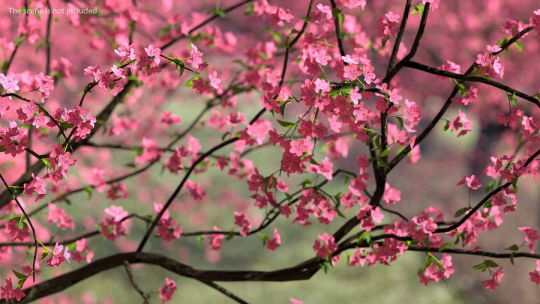
Mela (メロコ Meloco) - Peach Tree: You'd think Mela would be named after the pepper plant, but no, she is named after the Spanish word for peach. Go figure. (Fun fact, it is Rika the Ground-type user who is named after the pepper!)

Atticus (シュウメイ Shūmei) - Japanese Anemone: His English name is derived from the plant genus 'Hepatica.' The Japanese Anemone is a flower in the buttercup family, native to Asia.

Ortega (オルティガ Ortiga) - Stinging Nettles: A traditional medicinal herb, this plant has stinging hairs that irritate skin if touched. A pretty aggressive plant!
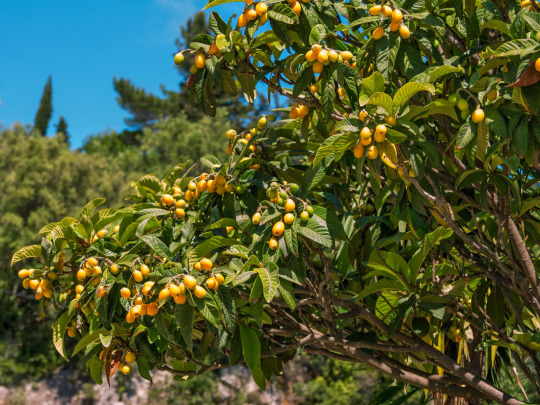
Eri (ビワ Biwa) - Loquat: A fruit tree native to China and popular in Japan. If you're from the US, you might have heard it called "Japanese plum" or "Chinese plum." Eri is dervied from the plant's scientific name 'Eriobotrya japonica.'
Gym Leaders
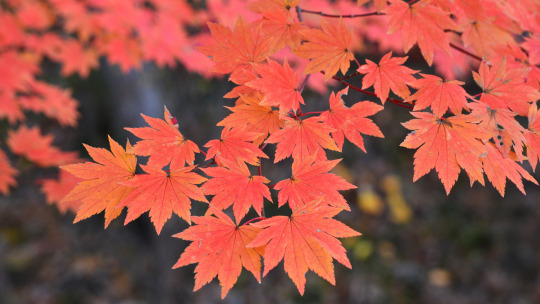
Katy (カエデ Kaede) - Maple Tree: In addition to being named after the maple tree, Katy's English name might also be a play on 'Katydid'

Brassius (コルサ Colza) - Rapeseed: This plant is in the Brassicaceae family, which are a wide range of cultivated crops in the mustard family. Rapeseed in particular is best known for the vegetable oil made from its seeds (canola oil)
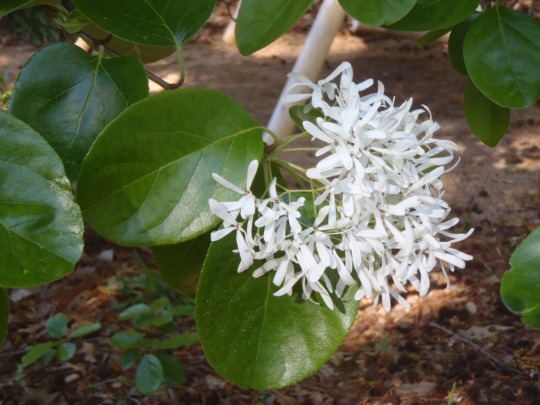
Iono (ナンジャモ Nanjamo) - Chinese Fringetree: A species of tree in the olive family that is native to Asia and produces many pretty white flowers. The Japanese name for Iono is a name used for unknown trees (literal translation: "What is it?"), with the Chinese Fringetree often being the culprit of an unknown tree. Likewise, Iono's English name is supposed to sound like "I dunno"
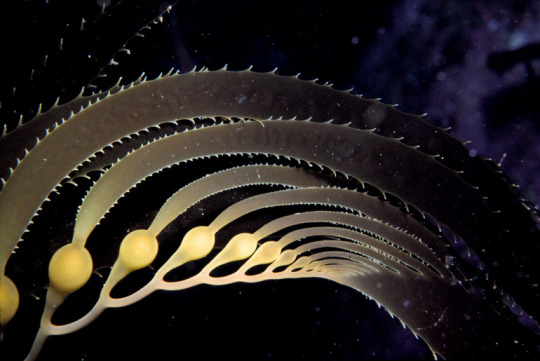
Kofu (ハイダイ Haidai) - Kelp: There are many, many species of seaweed; Kofu's English name refers to a group of edible kelp in particular (often called 'kombu')

Ryme (ライム Lime) - Lime: A play on the words "lime" and "rhyme"

Tulip (リップ Lip): In this case, there is no mystery what plant her English name is referring to!
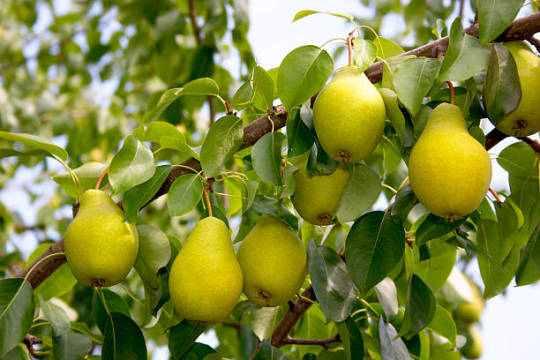
Grusha (グルーシャ Grusha) - Pear Tree: Yeah, Grusha is named after pears. The Russian word for pear, in particular. I have no idea why. Pear trees do have white flowers, so perhaps that's why.
Paldea League

Rika (チリ Chili) - Chili Pepper: Her English name is short for 'Paprika' and her Japanese name is a pun (chili and 地 chi - ground)

Poppy (ポピー Poppy): Again, just like with Tulip, this name is already obvious for English speakers!

Larry (アオキ Aoki) - Spotted Laurel: A shrub with pretty gold specks on its leaves; thrives in damp environments

Hassel (ハッサク Hassaku) - Hassaku Orange: This is a hybrid citrus tree between an orange and a grapefruit

Geeta (オモダカ Omodaka) - Threeleaf Arrowhead: An aquatic plant that grows in swamps and has a starchy tuber that can be eaten. Her English name is derived from the genus Sagittaria.
Main Cast
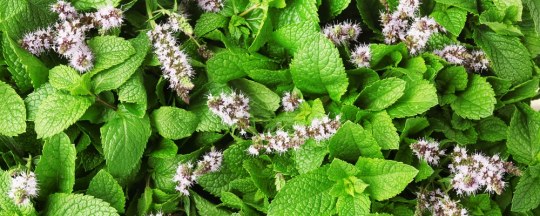
Arven (ペパー Pepper) - Peppermint: Arven is named after the peppermint plant, although his English name derives from the scientific name for a close relative, the corn mint (Mentha arvensis). I like to think Arven was named after peppermint for being a bit 'spicy' and terse when you first meet him, but that is just my wild speculation.
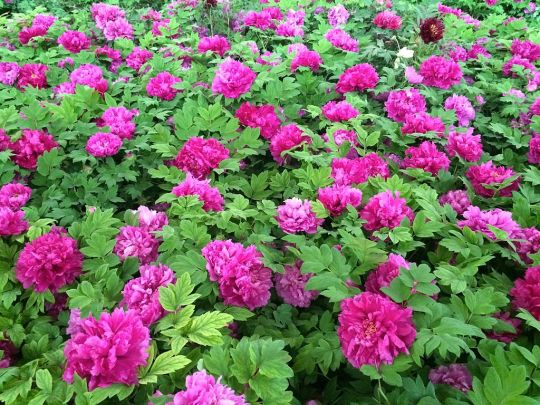
Penny (ボタン Botan) - Peony: Penny is named after the peony flower; the tree peony in particular, which is a manmade cultivar that is a shrub/tree rather than herbaceous. The tree peony is incredibly popular in China, for both ornamental and traditional chinese medicine reasons.
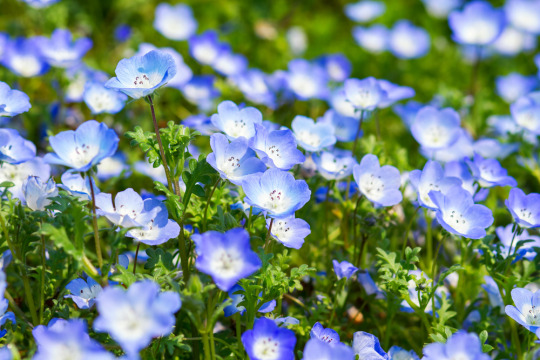
Nemona (ネモ Nemo) - Baby Blue Eyes: The Baby Blue Eyes is a native wildflower to North America (California & Oregon in particular), unlike a lot of the plants on this list. Nemona's name derives from its scientific name in particular (Nemophila menziesii). It bothers me to no end that Nemona is named after a plant called 'baby blue eyes' when her eyes are orange; the California poppy (which is bright orange) seems to make more sense for her? But, who knows what went on in the naming process.
Juliana (アオイ Aoi) - While the player character names are not directly named after a plant, they are inspired by plants in general. Juliana's Japanese name is a pun that means 'springtime' and 'green/young' (her English name comes from the word 'juvenile')
Florian (ハルト Haruto) - Florian's Japanese name, on the other hand, is a pun with 'springtime' and 'spring.' His English name comes from 'flower.'
25 notes
·
View notes
Link
Astronauts on board the International Space Station are often visited by supply ships from Earth with food among other things. Take a trip to Mars or other and the distances are much greater making it impractical to send fresh supplies. The prepackaged food used by NASA loses nutritional value over time so NASA is looking at ways astronauts can produce nutrients. They are exploring genetic engineering techniques that can create microbes with minimal ingredients. Many of us take food and eating for granted. The food we can enjoy is usually flavoursome and the textures varied. Astronauts travelling through space generally rely upon pre-packaged food and often this can lack the taste and textures we usually enjoy. Lots of research has gone into developing a more pleasurable dining experience for astronauts but this has usually concentrated on short duration trips. The space station’s Veggie Facility, tended here by NASA astronaut Scott Tingle, during the VEG-03 plant growth investigation, which cultivated Extra Dwarf Pak Choi, Red Russian Kale, Wasabi mustard, and Red Lettuce and harvested on-orbit samples for testing back on Earth. Credits: NASA During longer term missions, astronauts will have to grow their own food. Not only due to the nutritional issues that form the purpose of this article but carrying prepackaged food for flights that last many years becomes a logistic challenge and a launch overhead. To address the loss of nutritional values, the Ames Research Centre’s Space Biosciences Division has launched its BioNutrients project. The team has announced they has come up with a solution, thanks to the wonders of genetic engineering. The approach that the team has developed involves microbial based food (similar to yeast) that can produce nutrients and compounds with small amounts of resources. The secret is to store dried microbes and take food grade bioreactors along on the trip. Until now I never knew what a bioreactor was nor that they even existed. I live in the world of physics and astrophysics so this concept intrigued me. Turns out that a bioreactor does just what it says. It is a container of some form, often made from steel) inside which, a biologically active environment can be maintained. Often chemical processes are carried out inside which involve organisms undergoing either aerobic or anaerobic processes. They are often used to grow cells or tissues and it is within these that NASA pins their hopes on cultivating food in space. Even years after departure, the dried out microbes can be rehydrated many years later and cultured inside the bioreactor, creating the nutrients astronauts need. To date, the team has managed to produce carotenoids (a pigment found in nature) which are used for antioxidants, follistatin for muscle loss and yogurt and kefir to keep the gut in good health. The real challenge though is making food that the astronauts will want to eat. Source : BioNutrients Flight Experiments The post Astronaut Food Will Lose Nutrients on Long-Duration Missions. NASA is Working on a Fix appeared first on Universe Today.
2 notes
·
View notes
Text
Origin of kashmiri pandit cuisine
The cuisine of Kashmiri Pandits, an ethnic group native to the Kashmir Valley in India, has a rich and diverse culinary heritage deeply rooted in the region's history, geography, and cultural influences. Kashmiri Pandit cuisine, also known as Kashmiri Brahmin cuisine, is characterized by its unique flavors, delicate spices, and traditional cooking methods.
The origin of Kashmiri Pandit cuisine can be traced back to ancient times when the Kashmir Valley was a melting pot of various cultures, including Persian, Central Asian, and Indian influences. Over the centuries, these diverse culinary traditions blended with local ingredients and cooking techniques, giving rise to the distinct cuisine of the Kashmiri Pandits.
Some key factors that have shaped Kashmiri Pandit cuisine include:
Geographical Influence: The Kashmir Valley is blessed with fertile land, abundant water resources, and a temperate climate, which allows for the cultivation of a wide variety of fruits, vegetables, and grains. This abundance of fresh produce has had a significant impact on the ingredients used in Kashmiri Pandit cuisine.
Historical Influences: Kashmir has a rich history of trade and cultural exchange with neighboring regions, including Persia (modern-day Iran), Central Asia, and the Indian subcontinent. These interactions brought new ingredients, spices, and cooking techniques to the region, which were incorporated into Kashmiri Pandit cuisine over time.
Religious and Cultural Practices: Kashmiri Pandits follow Hinduism, and their dietary habits are influenced by religious beliefs and cultural practices. As a result, Kashmiri Pandit cuisine is predominantly vegetarian, with a focus on dairy products, grains, vegetables, and legumes. However, some non-vegetarian dishes are also part of the cuisine, although they are less common and usually reserved for special occasions.
Use of Spices and Flavorings: Kashmiri Pandit cuisine is known for its subtle yet complex flavors, achieved through the use of a variety of spices and flavorings such as saffron, fennel seeds, ginger, cinnamon, cloves, and cardamom. These spices are used judiciously to enhance the natural flavors of the ingredients without overpowering them.
Traditional Cooking Methods: Traditional Kashmiri Pandit dishes are often cooked slowly over a low flame to allow the flavors to develop gradually. Dum cooking, where food is sealed in a pot with dough and slow-cooked over a low flame, is a common technique used to prepare dishes like dum aloo and dum biryani.
Some popular dishes in Kashmiri Pandit cuisine include Rogan Josh (a slow-cooked lamb curry), Dum Aloo (potatoes cooked in a spicy yogurt gravy), Haak Saag (collard greens cooked with mustard oil and spices), and Modur Pulav (sweet saffron-infused rice). These dishes reflect the rich culinary heritage and cultural diversity of the Kashmiri Pandit community.
#food#kashmir#kashmiri pandits#kashmiri saffron#kashmiri kesar#indiancusine#india#foodie#finedine#restaurant
2 notes
·
View notes
Text
A Discourse on Ranch
Let’s begin with language. The English words salad and sauce both come from the same Latin root, the word sal meaning “salt”. In Latin, salsa means “salty” and salata means “salted”. Later, in Latin, “salsa” became the word for a liquid or semi-liquid food, containing salt, which is used to bring flavor to other foods. The famous garum salty fish sauce of the ancient Romans is a perfect, early example of the concept. “Salsa” entered some Latin-based languages intact (in Italian and Spanish). A different Roman dish, herba salata or “salted greens”, became the French abbreviation herbes salade and then just salade in roughly the 14th century. At about the same time in the same place, the French converted the Latin word salsa into a new French word, sauce. The point here is that salads and sauces are closely related, and come to us via the Roman Empire and particularly the French part of it. And, if you think of it, the “dressing” you put on a salad is really a sauce; it only becomes called “dressing” in English when you put it on a salad. Here, we will use “dressing” and “sauce” more or less interchangeably. But more on that later. Salads have varied in popularity over the years. At some points in history, raw salads were seen as dangerous as they still are in places where water is unsafe or raw manure is used to fertilize fields. Cooking vegetables neutralizes dangerous bacteria, after all. At other times, however, the virtues of raw-vegetable salads- especially ones based on lettuce leaves- were celebrated for being healthful and enjoyable.

"Lettuce" from the Tacunium Sanitatis, ca. 1450 One can find references to salads- accompanied with a sauce to “dress” them- throughout the culinary history of Italy, France, and even England. A memorable example comes to us from the English gentleman John Evelyn, who in 1699 composed the book “Acetaria: A Discourse on Sallets”, a complete guide to growing, preparing, and eating…. salads. Evelyn was a true salad enthusiast and passionate advocate for the healthfulness and flavor of salads, and prepared detailed notes on which plants were well-suited for cultivation and consumption. He only describes a single sauce for dressing salads, however, which he calls by the ancient Greek word oxoleon meaning “oil and vinegar”. Evelyn’s recipe includes olive oil, vinegar or citrus juice, salt, mustard, horseradish, grains of paradise (a kind of gingery pepper), and beaten eggs. This would serve as a delicious dressing even today. We can therefore think of the oil-and-vinegar mixture as the classical salad sauce, which contains four fundamental elements:
Classical Salad Dressing Formula
Something fatty (olive oil)
Something sour (vinegar)
Something salty (salt)
Something spicy (pepper, mustard, etc). Today, this formula is seen by Italians and French as the fundamental salad dressing: I once had an Italian teacher who would say “Olio, aceto, sale, pepe, e BASTA!” (“oil, vinegar, salt, pepper and DONE!!”) However, from very early times, cooks started finding ways to use other ingredients in salad sauces, either to add complexity or to substitute for the four classic ingredients above. Enter Mayonnaise
In deep history, Mediterranean cooks- probably from Spain or France- noticed that oil could be made creamy by mixing in an emulsifying ingredient: crushed garlic beaten with oil makes aioli, for example. By using various emulsifiers like egg yolk, ground mustard seeds, and even mashed potato, cooks began to emulsify oils into creamy sauces. One example of this is the French remoulade. By the 18th century, the habit of making emulsified sauces grew and mayonnaise- possibly named after the Spanish port city of Mahón- came into culinary fashion. Mayonnaise was made with oil, salt, spices like mustard and a touch of vinegar- the same basic ingredients as a vinaigrette salad dressing- and so it very naturally came to be seen as sort of a creamy version of a salad sauce. Egg yolk- a powerful emulsifier- began to be used often. Mayonnaise was used as a salad dressing for hundreds of years- indeed in the UK “Salad Cream” is a kind of mayonnaise and in the US the mayo-like Miracle Whip is marketed as “salad dressing”. In short, about 200 years ago, Europeans started using mayonnaise as a salad dressing, and using it often. Mayonnaise makes sense as a salad dressing all by itself, since it contains all of the elements of the Classical Salad Dressing formula, just emulsified together. One could also mix other elements with mayonnaise- like extra vinegar or spices- to make more complex salad dressings. The Milk-Eaters There is a great traditional divide in European cuisine between those who rely on milk products for fat and those who rely on olive oil for fat. This is often known as the “butter-olive oil divide”. Since olives thrive in the warmer climes of the Mediterranean countries, these are the “oil eaters”. Since cooler climes favor animal husbandry and make keeping milk easier, these are the “milk eaters”, who use butter, cream, and milk for their fat. It didn’t take long for the classic salad sauce dressing to encounter the oil/milk divide, and soon northern salad makers began to substitute milk or cream for the oil or mayonnaise in their salad dressings. In their 1878 cookbook “Wholesome Food”, Dr. and Mrs. Edmund Saul Dixon of London include a recipe for “Salad Mixture B”, an alternative to oil and vinegar (which was, of course, Salad Mixture A). They said Mixture B- a salad dressing based on cream, vinegar, salt and pepper, was “For those who are prejudiced against the very name of oil, often because they never tasted it; or, possibly, tasted it without knowing what it was.” Dairy-based salad dressings became popular in the northern European countries, especially Germany, Scandinavia, and England, and among immigrants from those countries to the US. In 1898, the “Home Queen Cook Book” contains 34 recipes for salad dressings, 25 of which contain dairy. Creamy dressings- white, emulsified salad sauces- became the norm in the United States, especially in rural areas where dairy was plentiful but oil was rare. The classic creamy salad dressing- sometimes boiled for thickness- followed the following formula, an adaptation of the classical salad dressing formula: Creamy Salad Dressing Formula
Something fatty (cream, milk, or butter)
Something sour (vinegar)
Something salty (salt)
Something spicy (pepper, mustard, onions)
Enter Buttermilk Every milk-eating culture has its fermented milk foods; sour cream, cultured butter, yogurt, etc. In these foods, bacterial action creates sourness, which extend shelf life and add unique tart flavors. Throughout Europe and among Northern European immigrants to the US, people used sour milk products in recipes, and eventually realized a soured milk product could be used to bring tartness to salad sauces instead of vinegar. This meant it was possible to use milk products for either or both the the “something fatty” and the “something sour” in the classic salad dressing recipe, and indeed this is exactly what people started to do. A great example is the German and American “Boiled Dressing” which uses cream, vinegar, salt and pepper, and was seen as an alternative to mayonnaise as a salad sauce. Boiled dressing was extremely popular in the 19th century and was used on a variety of salads both raw and cooked. Sour cream became a popular choice too, since it had the benefit of being both fatty and sour at once. And, finally, buttermilk: this sour-tasting byproduct of butter-making was perfect for salad dressings: it was tart, cheap, and nutritious. Buttermilk dressing became very popular, particularly in small towns in the American West and Midwest, and is represented in dozens of cookbooks from the late 19th and early 20th century. Here is a representative recipe from an Idaho Farm Bulletin in 1927: Buttermilk Dressing for Salads ½ pint thick buttermilk¼ pint mayonnaise dressing
Juice of ½ small onion
½ tsp. lemon juice
¾ tsp. salt
¼ tsp. mustard
⅛ tsp. paprika
⅛ tsp. white pepper
Fold all the ingredients into the unbeaten buttermilk.
You can see that this is just an combination of the Classical and Creamy salad dressing formulas, combining elements of both into a third salad dressing category: Buttermilk Salad Dressing Formula
Something fatty (mayonnaise)
Something sour (buttermilk)
Something salty (salt)
Something spicy (mustard, pepper, onions, herbs)
Since creamy dressings were already very popular, especially in the rural US, buttermilk dressings became popular too; they weren’t all that different from traditional cream dressings, but included soured milk, which was seen as thrifty and healthy. Now, if I were to make the buttermilk dressing above for you today, you would call it “ranch”. It is identical to many modern ranch dressings. But it wasn’t "ranch" yet. “Ranch dressing” had yet to be invented. Here’s how it happened. The “Invention” of Ranch Dressing
The creation story you’ll find about ranch dressing centers around Steve Henson, a Nebraska native who moved to Alaska in 1949 as a plumbing contractor. As the story goes, Steve would cook for his plumbing crews, and they became fond of a salad dressing he made. Henson’s success as a contractor led to an early retirement in California, where he and his wife founded the Hidden Valley Ranch, a guest ranch with a restaurant on the San Marcos pass near Santa Barbara. There, Hudson and his wife hosted legendary parties and dinners, which featured his secret invented-in-Alaska dressing, delicious steaks, and storytelling from Steve Hudson himself. Now, the question is, what was that dressing? Though the “Hidden Valley Ranch” dressing recipe has always been kept secret, former employees have said the original version of the sauce contained buttermilk, mayonnaise, onions, garlic, salt, pepper, and herbs. This recipe is clearly an example of the well-established buttermilk dressing formula above. It’s at this point we should mention that Steve Henson had what at least one of his friends, Allen Barker, called an “artistic truth... in the sense that…Steve told you what you wanted to hear.” In other words, Steve was a storyteller, a raconteur, and an embellisher of tales. The Hidden Valley Ranch wasn’t actually a ranch, it was a motel in the mountains. The bear rug in the motel, which Steve claimed he made after he killed the beast in Alaska, was actually a rug he found at a dump. Alaska seemed to be the location of many of Steve’s tall tales. Therefore, we should take the whole Alaska invention story, like all of Henson’s stories, with a grain of salt. The other Salad Dressing Craze Let’s rewind the clock a few years. In the West, the Palace Hotel in San Francisco had the reputation of being the source for many culinary trends. One of these was the Green Goddess Salad, invented by chef Philip Roemer in 1923 in tribute to the stage play of the same name. The dressing for the salad was based on mayonnaise and vinegar, flavored with the herbs tarragon, parsley, chives, along with garlic and anchovy. The herbs took center stage in this dressing, hence the name. Green Goddess salad dressing grew in popularity throughout the 20th century and by the 1950s it was celebrated by food critics and travelers as “the quintessential California salad dressing”. Premade versions even became available in markets.
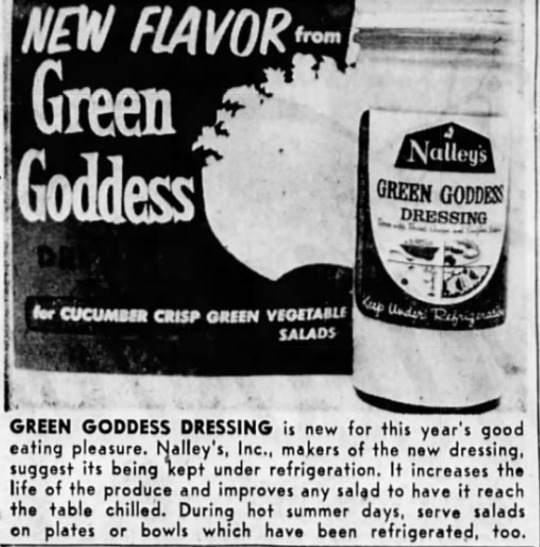
Steve Henson had to have known about the Green Goddess trend, and his guests at the Hidden Valley Ranch were certainly primed to become excited about a new, secret-recipe dressing. It seems likely that Steve Hudson took a basic buttermilk dressing, sprinkled some Green Goddess-style herbs in there, and dubbed it his secret “Hidden Valley Ranch” dressing. The Alaska origin story is doubtful. Though it makes sense that Hudson might have made buttermilk dressing while cooking for big groups in Alaska (are Alaskan construction workers big salad-eaters?), he probably wouldn’t have had access to fresh herbs. It seems certain that this story was a California flourish. It was also at about this time that Hudson added another “secret ingredient” to his dressing: MSG. The “flavor enhancer” Ac’cent had become available in the 1940s, and according to insiders the Hidden Valley Ranch used it in their dressing. A dressing legend was born. Steve Henson, knowing a good thing when he saw it, began selling his dressing to neighboring restaurants. One of these, the Cold Spring Tavern, still serves Henson’s ranch dressing, alongside local favorites like barbecued tri-tip and wild game chili.
Soon, Henson began working on a spice-mix version of the dressing, which needed only to be added to buttermilk and mayonnaise to create the signature Hidden Valley Ranch flavor. This was Henson’s true invention- the idea that, instead of selling perishable dressing in a jar, he would package the “secret seasonings” for his “Hidden Valley Ranch Dressing”. These packets contained powdered garlic, powdered onions, salt, pepper, dried parsley, and MSG along with dextrin powder, a kind of starch. He began selling the packets as a dip and dressing mix, and pretty soon he shut down the guest ranch to focus solely on packet production. Henson loved to create a mystique around the brand, featuring a cowboy on the label, playing up the Alaskan origin story, and building a restaurant and supermarket clientele. Hidden Valley Ranch became so successful buyers came calling, and packets of Hidden Valley Ranch Dressing and Dip mix became popular, first in California, and then throughout the United States.
Why did Ranch become so popular?
In the 1960s, as Henson was growing the Hidden Valley Ranch dressing mix company, consumers were primed for a new dressing trend. Freshly tossed salads were becoming more fashionable, as “composed” salads- the molded salads common in the early 20th century- became passé. Hidden Valley Ranch Dressing provided an alternative to vinegar-and-oil, along with a story of Western ranches and California living. “Ranch” was a potent word in the American midcentury- remember “ranch-style homes” were a thing, “Rawhide” and “Bonanza” were the most popular shows on TV, and western style living- epitomized by Sunset Magazine- was definitely “in”. Hidden Valley Ranch Dressing fit in with multiple trends: salads as a part of healthy eating, western-ness, and- perhaps most of all- convenience. Henson’s flavoring packets- which really contained only a few herbs, spices, salt, and MSG, made it seem easy to make a restaurant-quality salad dressing at home. Henson had based his formula on dried and granulated flavorings, which were being perfected in the 1950s. And, using a spice packet along with mayonnaise and buttermilk seemed close enough to “real cooking” to make Americans feel as if they were making something special.

The Ranch Explosion
Hidden Valley Ranch Dressing began getting more and more popular- even beyond the west coast. Remember, in rural America, buttermilk dressings- and creamy soured milk-based salad dressings in general- had already been popular for more than 100 years. In places like Henson’s birthplace of Thayer, Nebraska, creamy, white salad sauces were a kitchen classic. So, in rural America, Hidden Valley Ranch Dressing had a different meaning- it was a continuation of a salad dressing tradition, a commercially available version of a homemade staple, and a tribute to the farms and ranches of middle America. Hidden Valley Ranch Dressing was one of those products that could appeal to consumers on the coasts and to rural areas equally, though for slightly different reasons.
In 1972, seeking to diversify into food products, the Clorox company bought the Hidden Valley Ranch Dressing company. This event signifies Ranch’s transition from a small-but-growing dressing brand to a full-on category. For one thing, during this time, powdered buttermilk was added to the mix, making it even easier to make: now one only needed to add fresh milk and mayonnaise to the contents of the packet. Also, Clorox began marketing premade, shelf-stable bottled dressings in supermarkets. The green flecks of dried parsley- once a big part of Hidden Valley Ranch Dressing’s appeal, began to dwindle in the recipe. These innovations made Hidden Valley Ranch even more popular- and imitators began marketing their own “Ranch” dressings. The Hidden Valley Ranch Dressing brand now was one among dozens of “ranch” dressings, which was becoming an entire category of salad dressings. But, in the great tradition of salad dressings being a sauce anyway, people used ranch for way more than just salads, serving it as a sauce for a great variety of foods. Meanwhile, the inclusion of buttermilk powder in the spice mix made it possible to sprinkle it on anything to give it a “ranch” flavor: from steaks to french fries. The ultimate example of this might be the 1986 introduction of “Cool Ranch” Doritos, which included buttermilk powder, dried garlic, onion, and MSG. Nowadays, any tangy, creamy dressing with onions and garlic will be instantly identified as “ranch”, and any product sprinkled with dried buttermilk and onion and garlic powder will instantly seem “ranch-flavored”. In Conclusion
Today, the ranch dressing phenomenon seems like a weird American quirk. For one thing, it is a goopy, white sauce, laden with fat, salt, and flavorings. Consumers can be seen dipping onion rings and pizza crusts in ranch, and it has become the mandatory sauce served with “hot wings”, a version of deep-fried chicken. Ranch has developed an identity as a tacky indulgence, a proletarian addiction, and the epitome of common bad taste. In truth, however, Ranch dressing is a sauce which has in its history the classical Mediterranean, European cuisine, and the American frontier. It’s a sauce that- under different names- has been with us for hundreds of years. Its re-invention is in many ways the classic American story: Steve Henson took an old recipe and gave it a clear, new, romantic identity. Big food turned it into an inexpensive, abundant, shelf-stable product that could be eaten more or less daily.
7 notes
·
View notes